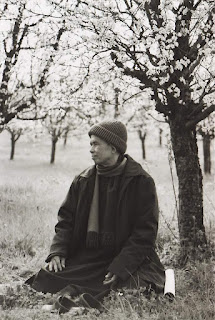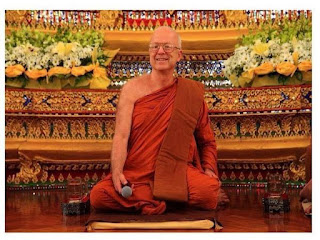My Story: Part 1
I thought it’d be good to share more about myself since I have been helping Luang Phor Samruay with his projects. Personally, I’m a reserved and private person. I don’t like being in the limelight or public eye, which is why I never really revealed my identity or photos until recently. However, handling donations require transparency and accountability. This is why I am also careful to keep a record of who donated what and how much, which I update regularly on the page.
I have a strong affinity with Buddhism.
If I had been born in Thailand, I would likely have ordained already. Ajaan Phitthinat knows this without me telling him, he said that I was born in the wrong country for some reason.
But I myself know the reason, it was because my mother made a very strong wish after having been childless for some time (see the power of adithan).
Not long after, she discovered she was pregnant and I was born on the 4th day of the 4th lunar month, which coincidentally is Manjushri Bodhisatta’s birthday. I also have some affinity with Manjushri Bodhisatta and he rescued me from a very dangerous situation before, but that is a story for another time.
Even when I was young, I remember in primary school, I had a very strong sense of Dukkha (Unsatisfactoriness of life) and Anicca (Impermanence) but I couldn’t really put my finger on it. I hadn’t been born into a Buddhist family so I didn’t know how to label these concepts.
After my grandmother passed away, she appeared in my dream 1 or 2 weeks later and told me she was moving on, and that I should become a Buddhist. I felt it was somewhat ironic considering she was of another religion.
But it was only years later when I finally embraced Buddhism in secondary school.
Finally I could put a name on the feelings I had towards life. But I still hadn’t started practising yet.
Until a chance encounter at the start of 2013, one friendly Buddhist DXO (civilian officer) asked me whether I wanted to join him and go for a talk by Tahn Ajaan Viradhammo which would be held at the (now defunct) Dhamma Wisdom Centre. I had never been to this temple before so I thought why not. At that time, I was still serving National Service and was due to ORD (complete my service) in a few months.
I can't remember a single word of what Ajaan Viradhammo said, but what struck me was how serene, beautiful and amazingly calm this meditation centre was. I returned one more time when I was in Kembangan just before I was due to ORD. It was on that day when I met Ven Dr. Phra Maha Winyoo, whom we just address as Maha. I realised that he was the resident monk at the centre and he invited me to come to join them often.
Maha’s temperament and personality was very suitable for my disposition, as he was a very open-minded, humble, easy-going and friendly monk. I went to the centre almost everyday from Monday to Sunday to practice meditation with Maha Winyoo and read Dhamma books together with him. It was fortunate I discovered this centre right before I ORD-ed and had the spare time to practice daily from April until I entered university in August 2013.
This was a very important period in my life as Maha Winyoo focused purely on Anapanasati, Vipassana and the Satipatthana, which are very basic fundamental techniques that every Buddhist should understand and practice first.
Maha also taught me how to chant in Pali, which we did together every evening. He was always kind towards me and would tell me stories about his tough childhood and life in Thailand after chanting in the evenings.
I still remember that I was rather doubtful and asked Maha many questions at the start.
I told him, “How can I be sure that the Buddha’s teachings are true? Also, how can I be sure that rebirth and kamma exist?” Maha just smiled and told me to start practising first, and so I did.
Walking meditation, sitting meditation and reading of Dhamma books. This is what we did together every day.
Because DWC was not a very popular place during weekdays, it was mostly Maha and myself most of the time. So I got the chance to practice intensively. During these 4 to 5 months, during my practice, certain insights arose which convinced me that this was the path towards the ending of Dukkha...
--------------------------------------
This post is getting a bit long so I have decided to stop here for now. But I must say that I was very fortunate to meet Maha, and I am truly and deeply indebted to him. Maha Winyoo is not an eloquent monk and doesn’t teach or preach the Dhamma much. But he gave me the space and resources to practice and demonstrated to me how a good monk should practice and behave.
Eventually the centre closed and he had nowhere to go. But the Dhamma takes care of people who practice the Dhamma. Chao Khun Keng kindly took him in at Wat Palelai and he was not forced to return to Thailand. Even there Maha was known as the walking monk because of the hours he put in walking back and forth in meditation.
A photo taken almost 10 years ago in 2013 at DWC.
********
My Story Part 2:
Studying and Going to Wat Tham Muang Na for the First Time
I have always been someone who excels at his studies. But being academically inclined has never brought me any lasting happiness.
When I was in Primary 3, I passed both aptitude/IQ tests and got into the Gifted Education Programme. For non-Singaporeans: this is something done in Singapore, where students aged 9 are made to sit for special difficult selection papers aimed at identifying the top 0.25-1% of students with outstanding intelligence (according to Wikipedia at least - neither the best nor most reliable source around).
Well, I decided to drop out of that programme and go to an ordinary neighbourhood secondary school - Presbyterian High School, after my PSLE (when I could have gone to Raffles Institution or Hwa Chong or something). I greatly enjoyed my time in PHS by the way, best years of my life. Plus it was near my house too.
Anyway, repeating this pattern, despite doing well, I gave up studying Law at SMU after 1 semester and transferred to NUS to major in Sociology. (Again, no regrets there, I made great friends in NUS) But what struck me when I was reading Law was that I was back to square one again with regards to my Dhamma practice. When I faced real life stresses and pressurising situations, my sati (mindfulness) is still unable to catch up with the kilesas (defilements).
I also noticed Dukkha (unsatisfactoriness) clearly. Many of my peers who read Law didn’t do so because it was their passion. Some did it for the potential renumeration of the career, others did it for the prestige, and some because they just did well and at that time, Computing wasn’t so hot yet. But many of them, who were from middle to upper class families, weren’t truly happy. So I realised doing well in life doesn't guarantee happiness either. And that very few people knew what they wanted to do in life.
I was fortunate that my parents didn’t oppose my decision to leave, my mom said that she just wanted me to try it out, and if I didn’t like it I could choose to do whatever I wanted. I wonder whether my parents ever felt disappointed with my life choices, but if they had, I am grateful that they have never openly expressed it and have always supported me all the while.
Reading Sociology gave me a lot of free time to go back to visit Maha at DWC, and also to continue catching up with the Dhamma. In 2015, conditions happened in such a way that changed my life’s trajectory – I saw a documentary video of Wat Tham Muang Na and its way of practice on the internet.
Oh I forgot to mention this in my earlier post, but I actually met someone when I was studying at Anderson Junior College who also wanted to ordain. We thought it was incredulous that two people who were interested in the monastic life were actually batchmates (a mutual friend introduced us – he told me, Aaron I found someone else who wants to be a monk). We thought - what were the chances? So while I was practising at DWC, my friend actually went to a Burmese meditation centre in Batu Pahat to practice intensely.
Okay so back to the story. My friend happened to go for exchange in Khon Kaen University at that time. Because I was lazy, I only took Thai 1 at NUS. But my friend was already taking Thai 6 or 7 or something. So he was extremely fluent in Phasa Thai while I could only ask hongnam yu thi nai (where's the toilet?). I definitely needed a guide to survive. So I showed him the video of Wat Tham Muang Na and asked whether he would be keen to stay there for several nights. He said sure.
After a 2 hour long ride from Chiang Mai, where my friend was nice enough to let me sit in the cabin while he sat in the back holding on to our luggage bags preventing them from falling off the Song Thaew, we finally reached Wat Tham Muang Na. When I stepped out of the vehicle, I looked around me and saw several buildings. I was a little disappointed.
What’s so special about this place that I travelled so long to find?
But then my friend asked around and we realised that Muang Na cave was up there on Level 5 or something. So after we got our key to our room from the nice lady at the guest reception office, we headed to the building (which was an extension of a hill with Tham Yai at the top), deposited our luggage and made our way upwards.
Finally, Tham Yai was right in front of my eyes.
It was beautiful.
I felt like I had finally reached home.
(Photo taken from the internet, story to be continued)
































